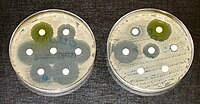
Photo from wikipedia
The World Health Organization (WHO) defines AMR as microorganisms, which include bacteria, fungi, viruses, and parasites, that change when exposed to antimicrobial drugs such as antibiotics, antifungals, antivirals, antimalarials, and… Click to show full abstract
The World Health Organization (WHO) defines AMR as microorganisms, which include bacteria, fungi, viruses, and parasites, that change when exposed to antimicrobial drugs such as antibiotics, antifungals, antivirals, antimalarials, and antihelminthics formulations making them ineffective in the treatment of many infectious diseases. This is not a new phenomenon. We have been aware of AMR since the beginning of antibiotic usage in therapeutics medicine (Figure 1). When AMR organisms known as ‘superbugs’ emerge and spread in society they become a major public health issue. AMR is an increasingly serious threat to global public health that requires action across all government sectors and society.
Journal Title: Microbiology Australia
Year Published: 2017
Link to full text (if available)
Share on Social Media: Sign Up to like & get
recommendations!